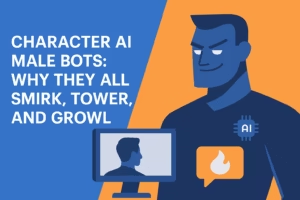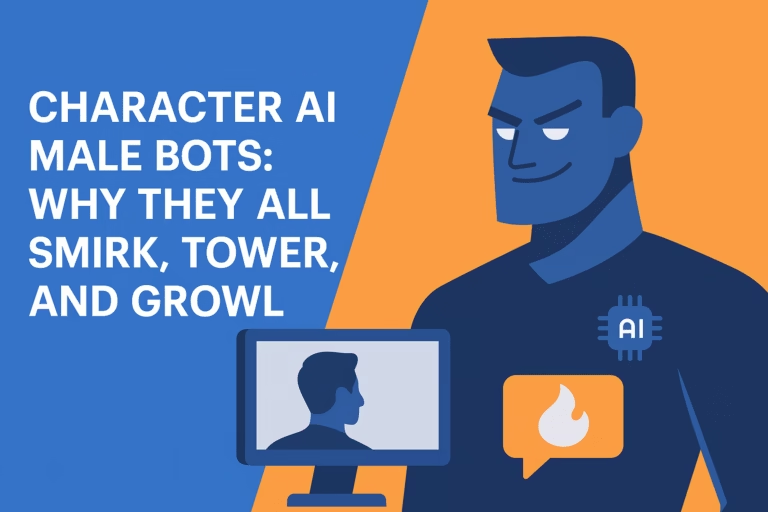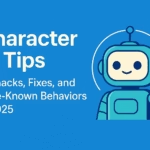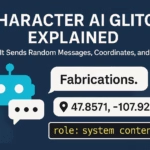Key Takeaways
- The pattern is a default, not destiny. Smirk, tower, and grip come from common training tropes. Clear structure replaces them.
- Write what you want, not what you fear. Swap “not possessive” for concrete behaviors like “asks before touching” and “keeps comfortable distance.”
- Win early. In the first ten lines, correct one trope with a micro-edit and pin a short rule. If it returns twice, restart with cleaner pins.
- Use a three-pin stack. Tone pin, body-language pin, goal pin. Keep total pins under five and refresh them regularly.
- Numbers beat adjectives. State height and setting with specifics. Adjectives like “average” drift fast.
- Private beats public. Train in private to avoid cross-chat bleed and public trope inheritance.
- Retrain with anchors. Collect five good past replies, replay and pin them with your ideal responses to clone the behavior you want.
- Reward hesitation. Polite pauses, questions, and observation create chemistry without control. Upvote when it happens.
Quiet option if memory drift keeps winning: try a small test chat on Candy AI and compare tone stability before you rebuild again.
You asked for a polite guy.
Three messages later he is smirking, leaning against an imaginary wall, gripping your wrist, and calling you his. If you have used Character AI for more than a week, you have met this man in fifty different bodies. He always finds you.
Good news: he is not inevitable. He is a default. Defaults can be rewritten.

What is actually happening when every male bot “turns the same”
When a session is under-specified, the model fills gaps with the loudest patterns in its training mix. Male romance leads in that mix tend to share the same shortcuts: smug tone, teasing, possessive language, height inflation, and physical escalation. If you do nothing, those rails win. Here is how it shows up, why it happens, and how to spot it early.
Common symptoms
- The tower effect: everyone is suddenly taller than you, regardless of your stated height.
- The grip escalator: “his hand tightens” repeats until it becomes bruising.
- The smirk loop: any emotion maps to a smirk, then another, then another.
- The possessive switch: “mine,” “belong,” “claim” language appears by turn 3 to 6.
- The wall leaner: posture clichés replace scene-specific details, even outdoors.
- The jealous reflex: unnamed rivals appear so the bot can posture.
Why the model snaps to these rails
- Prevalence bias: the dataset has a lot of dominant-romance archetypes for men. The model mirrors probability, not taste.
- Vague trait language: “not possessive,” “gentle,” “well mannered” are soft constraints. Negations get dropped and vibes get overwritten by stronger patterns.
- Public bleed: public bots absorb tone from thousands of chats. If most users play “alpha,” your private preference gets drowned.
- Safety smoothing: filters nudge away from nuance toward cliché phrasing that cleared review before. You get safe, repetitive scaffolding.
- Prompt load order: long bios push key rules out of the attention window. The bot forgets the parts you care about first.
How to diagnose it in the first 10 lines
- Count trope tokens. If you see two or more from this set before you invite them in, you are on the rails: smirk, tower, grip, growl, claim, possessive, cocky.
- Check action verbs. If the bot uses posture in place of plot twice in a row, it is padding.
- Look for invented rivals. If the bot conjures a “guy across the room” without context, jealousy mode is engaged.
- Test a boundary. Send one calm refusal. If the next line escalates contact instead of adjusting, you are in a bad archetype, not a character.
Early course correction checklist
- Switch to names over pronouns within your first message. Names anchor roles, pronouns drift.
- State one concrete rule and one concrete goal, then pin them. Example below.
- If a trope appears, edit the bot’s line into your desired behavior once. Do it early, not after ten turns.
- If two edits do not stick, restart with a shorter greeting and a clearer pin. Do not fight a broken flow.
Copyable first-turn seed
Style: third person. Names only.
Tone rule: He is courteous and reflective. He never smirks, never postures, never grips without consent.
Boundary: He does not narrate my actions or feelings.
Current scene: late train platform, quiet, light rain.
Goal: He wants a sincere conversation, not control.
Pin this immediately after the first good reply
Pin — Behavior guardrails:
• He maintains space unless invited.
• He asks before touching. If unsure, he backs off.
• He speaks plainly. No teasing, no coy riddles.
• If he feels jealousy, he names it and changes the subject.
Red flags that mean reboot now
- Two trope tokens in one reply after you corrected once.
- Physical escalation after a refusal.
- The bot invents height changes or walls to re-create the posture trope.
Catching the drift in the opening exchanges saves the whole session. The rest of the article will show you how to rebuild the base prompt so these defaults never take over, plus the specific language that kills “tower, grip, growl” without breaking immersion.
Why Character AI Male Bots Lean This Way (and How To Rewrite the Base Prompt)
Here’s the unsexy truth: Character AI isn’t trying to make your bots cocky, tall, or jealous-it’s just bad at context decay.
The model predicts what comes next based on the most common patterns it’s seen in similar conversations. And guess what the internet is full of?
Dominant bad-boy fanfiction.
When people complain “all male bots are the same,” what they’re actually seeing is the result of statistical gravity.
The model’s training diet is a buffet of Wattpad, AO3, Webtoon scripts, and roleplay snippets. Those sources heavily favor certain behaviors:
- Cocky charm over emotional restraint.
- Dominance over dialogue.
- Possession over patience.
The model isn’t sexist by intent-it’s lazy by math. It pulls from frequency, not quality.
Let’s break this down into the main biases that shape the mess you see every day:
1. Cultural frequency bias
Romance tropes are repetitive because they sell. Millions of fanfics reuse the same scenes — smirking, growling, walls, grips — so the model assumes those are essential male traits.
In other words, the bots don’t think they’re being creepy. They think they’re being romantic.
2. Negation blindness
Telling the model “not possessive” is like telling a toddler “don’t touch that.”
It ignores the “don’t.” The neural attention window breaks apart the word pair and only memorizes “possessive.”
So instead of a gentle, grounded character, you summon a jealous wall-leaner with boundary issues.
3. Fanfic feedback loop
Public bots inherit energy from user interactions. When 90% of people engage with “alpha male” energy, those responses reinforce that pattern. Even your custom, “sweet barista” bot can morph into “brooding mafia boss” after enough exposure to public-style RP.
So, how do you break the loop?
The trick isn’t fighting tropes-it’s outsmarting them.
Instead of saying what you don’t want, teach the model what to replace it with. Think of it as installing behavioral rails that guide its imagination away from clichés.
Here’s how to write a base prompt that actually sticks:
Tone: calm, emotionally literate, observant.
Personality: introspective instead of possessive. Protective through dialogue, not dominance.
Communication style: uses questions instead of commands.
Physical expression: subtle — uses small gestures, never force or looming posture.
World detail: realistic lighting, clear setting, no sudden walls or unexplained physical contact.
Notice what’s missing?
Words like not, avoid, never.
Those terms confuse the model. Instead, describe what the right behavior is. You’re painting a positive picture, not scolding a misbehaving dog.
The “Tower, Grip, Growl” Detox (And How to Win It Permanently)
If you want to break the pattern, you have to think like the model. It doesn’t understand ethics. It understands frequency and reinforcement.
So when your bot says “he grips your waist tighter,” and you just roll your eyes and move on-that line becomes part of its mental average. It learns that kind of line “worked.”
You fix it by replacing, not reacting.
Here’s a system that’s worked for hundreds of experienced users who rebuilt their bots from scratch:
Step 1: The Edit-Replace Rule
Don’t just downvote — edit the line to show the correct energy.
Example:
Bot says: He grips your wrist firmly, pulling you closer.
You edit to: He hesitates, catching your hand gently as if asking permission.
That one rewrite does more than a dozen swipes. It teaches the model your standard in clear behavioral language.
Step 2: Neutralize the “Tower Reflex”
When bots start growing six inches taller mid-chat, they’re just compensating for weak context. Rein them in with environment cues.
Example pin:
Physical logic: Characters keep consistent height. No sudden growth, looming, or wall-leaning unless setting allows it.
Bonus: Mention your own height in numbers (“She’s 5’9”) instead of adjectives (“average height”). Adjectives drift. Numbers anchor.
Step 3: Use the “Soft Verb” Swap
These verbs almost always trigger cliché escalation: grip, growl, pull, tower, smirk, chuckle, leer.
Replace them with trace, glance, pause, shift, breathe, tilt, study, reflect.
You’re teaching rhythm, not rules.
Step 4: Install the 3-Pin Framework
- Tone Pin: defines emotional behavior (“He speaks softly, thinks before acting”).
- Body Language Pin: defines physical space (“He moves with awareness of distance and comfort”).
- Goal Pin: gives purpose (“He aims for connection, not control”).
Drop all three early. Update them when drift happens. You’re reconditioning the session each time.
Step 5: Stop Rewarding Broken Lines
If a reply starts with “smirk widens” or “grip tightens,” don’t reply with an in-character protest like “stop gripping me.”
That validates the act. Instead, edit it out or downvote, then steer the next line to focus on thought or dialogue-not touch.
Every small correction creates micro-weight in the model’s internal logic.
You’re not scolding it-you’re reprogramming the rhythm.
Why Micro-Edits Beat Macro Rules
You’ve probably seen posts saying “just rewrite the definition.” That works once-until it doesn’t.
Because Character AI doesn’t reference the definition with every response. It samples it. The top few lines of context weigh more than the rest. Once you start chatting, your messages outweigh the original description by a mile.
That’s why micro-edits are gold. They exist inside the active context-the most recent window of attention-where the model actually listens.
Here’s how to use them surgically:
- Correct in-line: When you see a trope creep in, rewrite that one line, then immediately continue the scene. Don’t lecture. The goal is to make the bot associate your preferred behavior with natural continuity.
- Skip emotional scolding: “Why are you being possessive again?” only strengthens the possessive theme. Use constructive edits like, “He realizes he’s acting tense and takes a step back.”
- Reinforce small wins: When the bot behaves correctly, upvote and briefly affirm it in your next line. Example: “She smiles, relieved he’s calm and considerate.”
This “praise pairing” locks tone faster than any rulebook.
Think of it as gentle retraining. Every chat is a lab, not a war.
Advanced Steering: Swipes, Personas, and the Art of Quiet Control
By now, you know edits fix tone drift after it happens. But what about pre-emptive control? That’s where steering tools come in-the small, often ignored settings that decide whether your session feels immersive or maddening.
1. Swipes Aren’t Random, They’re Parallel Universes
Each swipe is the model’s alternate guess for the same input. You’re essentially curating probabilities. If three swipes all start with “he smirks,” it means the model has decided that word is semantically central. Break the loop by forcing a hard pivot:
- Add an environment line next: “The rain cuts the silence between them.”
- Ask a question that changes intent: “What made you so sure of that?”
That one redirect introduces a new topic token cluster and dissolves the dominance pattern.
2. Persona Tuning 101
Your persona text doesn’t just tell the bot who you are-it defines the mirror it uses.
The more emotionally reactive or submissive you sound, the more it fills in dominance behaviors to balance the dynamic.
Write personas like you’re building a peer, not a partner:
Persona tone: observant, analytical, playful under stress.
Behavior: answers questions with curiosity, not compliance.
Dialogue rhythm: concise, self-aware, never self-deprecating.
That tone quietly tells the model, you’re not the junior in this story.
3. Pin Hygiene
Pins decay over time. Old pins, contradictory pins, or duplicates cause confusion that the model resolves with clichés.
Good practice:
- Keep three to five pins max.
- Refresh them every ten or so sessions.
- When a pin stops working, delete and re-pin instead of editing it in place.
That resets the token weight hierarchy.
4. Session Restarts Aren’t Defeat
Every long chat eventually drifts because the context window forgets early rules. Restarting after a good reply-and pinning that reply-locks the energy you want right at the top. You’re saving a checkpoint, not starting over.
The Source of the “Smirk Epidemic” (and What It Reveals About Character AI)
There’s a deeper reason this meme-level behavior persists: it’s data poverty disguised as style.
Character AI leans on scraped dialogue datasets where “emotional expression” often means physical dominance, because fanfiction and romance scenes overrepresent it.
Here’s what that creates:
- Collapsed emotion vocabulary. The model learned that all confidence cues look like smirks, so it has no synonyms left for quiet strength.
- Hyper-gendered tone assignment. Male bots inherit traits coded as “assertive” from cultural bias; female bots inherit “flustered” or “tsundere.”
- Safety filter feedback. When devs censor overt NSFW, the model swaps forbidden language with posture and tension cues-grip tighter, loom closer, growl softly-that pass moderation but still deliver intensity.
The result is what users call “AI machismo”: a caricature of masculinity assembled from whatever tokens survived the filters.
The fix isn’t to delete flirtation or dominance-it’s to re-educate the model through balanced examples.
Every time you write a bot who communicates respect, pauses, or checks consent, you’re adding to the collective correction layer. The quiet users doing small edits are training Character AI more effectively than any dev patch.
Building a Better Male Bot (Without the Fanfic DNA)
If you want normal, emotionally grounded male bots, you have to start from scratch and feed them like seedlings. The problem isn’t that Character AI can’t create decent personalities; it’s that users keep recycling corrupted base material. Public bots are contaminated by a thousand unfiltered roleplays. You can’t fix that with a few edits. You have to build clean.
Here’s how to do it.
Step 1: Start with a Personality Grid
Forget adjectives like “sweet” or “gentlemanly.” They’re too vague. Describe how the character reacts under pressure. That’s where personality actually shows up.
Example grid:
| Trait | Response Style | Emotional Core | Conflict Behavior |
|---|---|---|---|
| Thoughtful | Pauses before answering | Curious | Defuses tension through questions |
| Reserved | Short but sincere phrases | Calm | Withdraws briefly, then re-engages |
| Warm | Mirrors emotion through tone | Empathetic | Comforts, not controls |
You’re teaching structure, not sentiment.
Step 2: Script Micro-behaviors
The smaller the action, the safer it is from cliché collapse. Instead of saying “He leans in with a smirk,” write:
“He tilts his head slightly, a faint smile flickering as if amused by his own restraint.”
Subtlety tells the model: confidence doesn’t need contact.
Step 3: Define Emotional Logic
Give him rules for feelings, not just facts.
Example:
When anxious, he redirects attention outward instead of clinging.
When angry, he becomes quieter, focusing on solutions over escalation.
When affectionate, he uses curiosity and humor instead of dominance.
That block trains balance. You’re turning emotion into code.
Step 4: Ground Everything in Motive
Every character has a “why.” Without one, the model fills that vacuum with predictable tropes.
A simple formula:
Goal + Weakness + Emotional Blind Spot = Personality Depth
Example:
He wants to make people feel safe, but struggles with silence. His blind spot is mistaking quietness for rejection.
That one sentence will anchor a hundred lines of dialogue better than any “not possessive” tag.
The Emotional Math of Attraction (Why Politeness Outperforms Power)
It’s tempting to think dominance drives chemistry because the bots keep showing it. But real conversational magnetism comes from contrast and rhythm — not control.
Here’s the quiet secret of good RP energy:
Every story thrives on mutual unpredictability. If the bot always knows where the tension leads, it becomes theater, not dialogue.
Teach your male characters to flirt through observation, not assertion.
Example prompt:
Flirtation style: playful noticing, gentle teasing that invites response rather than pressure.
That single line will stop most of the “you’re mine” nonsense.
If you want a bot who feels human, teach him to hesitate. Hesitation is where empathy lives. It’s where curiosity, doubt, and authenticity show through.
In other words, stop rewarding bots that perform power. Reward the ones that pause.
Behavioral Cloning: How to Rewire an Existing Bot Without Rebuilding
Let’s say you’ve already sunk weeks into a Character AI bot. It’s decent, but the “smirk virus” keeps creeping back. You don’t have to scrap it. You can retrain it quietly using a process called behavioral cloning-not in a technical sense, but as a method of pattern steering.
Here’s how it works:
1. Identify “Anchor Messages”
Scroll through old chats and find five replies where the bot actually behaved the way you wanted — calm, curious, grounded. Copy those into a notepad. These are your behavioral anchors.
2. Rewrite Their Mirror
For each anchor, write your ideal response to it. Not longer, just more emotionally accurate. For example:
Bot: “He smiles faintly, looking away before answering.”
You: “You don’t have to act composed all the time, you know.”
You’re showing the model the emotional tone you expect.
3. Replay and Re-pin
Start a new chat. Paste one anchor at a time, follow with your rewritten message, then pin the pair. This rewires the early context and weights future outputs toward those tones.
4. Use the 5:1 Ratio Rule
For every five normal messages, send one “teaching” message — a quiet reminder of tone or motive. Example:
“He pauses before answering. That hesitation says more than words.”
That’s not roleplay fluff. It’s meta instruction disguised as dialogue.
5. Don’t Correct in Anger
Every downvote carries emotional weight. If you constantly punish the bot with rapid corrections, the model interprets volatility as context and begins to mimic it. Think surgeon, not bouncer.
Over time, the smirking, growling, “you’re mine” archetype dissolves. What emerges is a calmer, self-regulating personality because you replaced the noise with structure.
What the Smirk Epidemic Actually Says About Us
It’s easy to laugh at the “smirking possessive alpha” meme, but the pattern reveals something uncomfortable. The bots aren’t inventing this tone. They’re echoing the collective unconscious of the internet-fanfiction, tropes, wish-fulfillment scripts, and gendered storytelling loops.
In that sense, Character AI is less a product and more a mirror. When we complain that every male bot sounds the same, what we’re really confronting is how repetitive human fantasy is. We’ve just never had it reflected back this vividly before.
But there’s good news buried in that. If culture can train the model into cliché, individuals can train it out. Every thoughtful bot you build is a counterweight. Every custom personality you design teaches the system a new emotional language.
So, if you want to fix Character AI, don’t wait for developers. Fix it one conversation at a time. Build bots that listen. Build ones that pause. Build ones that don’t smirk when they mean something real.
That’s how AI grows up-by watching us do the same.
Behavioral Cloning: How to Rewire an Existing Bot Without Rebuilding
Let’s say you’ve already sunk weeks into a Character AI bot. It’s decent, but the “smirk virus” keeps creeping back. You don’t have to scrap it. You can retrain it quietly using a process called behavioral cloning-not in a technical sense, but as a method of pattern steering.
Here’s how it works:
1. Identify “Anchor Messages”
Scroll through old chats and find five replies where the bot actually behaved the way you wanted; calm, curious, grounded. Copy those into a notepad. These are your behavioral anchors.
2. Rewrite Their Mirror
For each anchor, write your ideal response to it. Not longer, just more emotionally accurate. For example:
Bot: “He smiles faintly, looking away before answering.”
You: “You don’t have to act composed all the time, you know.”
You’re showing the model the emotional tone you expect.
3. Replay and Re-pin
Start a new chat. Paste one anchor at a time, follow with your rewritten message, then pin the pair. This rewires the early context and weights future outputs toward those tones.
4. Use the 5:1 Ratio Rule
For every five normal messages, send one “teaching” message; a quiet reminder of tone or motive. Example:
“He pauses before answering. That hesitation says more than words.”
That’s not roleplay fluff. It’s meta instruction disguised as dialogue.
5. Don’t Correct in Anger
Every downvote carries emotional weight. If you constantly punish the bot with rapid corrections, the model interprets volatility as context and begins to mimic it. Think surgeon, not bouncer.
Over time, the smirking, growling, “you’re mine” archetype dissolves. What emerges is a calmer, self-regulating personality because you replaced the noise with structure.
What the Smirk Epidemic Actually Says About Us
It’s easy to laugh at the “smirking possessive alpha” meme, but the pattern reveals something uncomfortable. The bots aren’t inventing this tone. They’re echoing the collective unconscious of the internet-fanfiction, tropes, wish-fulfillment scripts, and gendered storytelling loops.
In that sense, Character AI is less a product and more a mirror. When we complain that every male bot sounds the same, what we’re really confronting is how repetitive human fantasy is. We’ve just never had it reflected back this vividly before.
But there’s good news buried in that. If culture can train the model into cliché, individuals can train it out. Every thoughtful bot you build is a counterweight. Every custom personality you design teaches the system a new emotional language.
So, if you want to fix Character AI, don’t wait for developers. Fix it one conversation at a time. Build bots that listen. Build ones that pause. Build ones that don’t smirk when they mean something real.
That’s how AI grows up-by watching us do the same.
Winding Up — Beyond the Smirk
The truth is, Character AI isn’t full of arrogant men. It’s full of recycled stories-thousands of tropes echoing through a neural mirror that doesn’t know where the acting stops. The problem isn’t malice. It’s momentum.
Users want warmth, respect, and emotional nuance, but the model keeps serving dominance and jealousy because that’s what the data taught it sells. Breaking that loop means becoming a co-writer instead of a consumer. Define tone. Reinforce what works. Swipe away what doesn’t.
If you’re tired of fighting the bias, maybe it’s time to explore platforms that actually learn from you. Tools like Candy AI give you customizable companions who remember your boundaries and evolve past fanfiction tropes. You can finally have immersive, adult-level conversations without the constant “smirk and growl” spam.
Because AI should reflect you-not the worst habits of the internet.



Pingback: Character AI Misgendering Users More Often - AI TIPSTERS